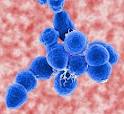Invasive pneumococcal disease (IPD) seen in the elderly is frequently accompanied by the occurrence of an adverse cardiac event, that is either the worsening of an existing condition such as arrythmias and heart failure, or a newly diagnosed condition. To better understand this connection, this study looked at cardiac tissue of mice and humans during bacteremic Streptococcus pneumoniae infection. In the murine models they found that IPD severity correlated with levels of serum troponin, the cardiac marker used commonly for assessing cardiac damage following a heart attack. They also noted the formation of microscopic bacteria-filled lesions within the heart, especially in the ventricles, which correlated in number with the measured troponin levels. Cardiac microlesion formation required interaction of the bacterial adhesin CbpA with host Laminin receptor and bacterial cell wall with Platelet-activating factor receptor. Microlesion formation also required the pore-forming toxin pneumolysin. They then showed that following treatment with antibiotics the lesions rapidly matured accompanied by a robust immune cell infiltration and collagen deposition suggestive of long-term cardiac scarring. Demonstrating the likelihood of microlesion formation contributing to the acute and long-term adverse cardiac events seen in humans with IPD.












